The ISCP has released new research from graduate Linda Cooper on the impact of exercise on reactive dogs (view study here). The study is fairly interesting in that it recommends reducing walks and arousal increasing activities such as fetch.
The dogs in the study were sent on a “doggie” vacation where exercise was significantly reduced. The owners of the dogs were nervous of this at first given that many of the dogs that participated were also described as hyper dogs that required great amounts of exercise.
What was found instead was that with reduced physical exercise (off leash running, long walks, playtime with other dogs, ball and disc play, etc.) and increased soothing touch and mental games the dogs improved significantly in only 6 days! The study goes on to cite work that includes giving dogs a drastic change for a month to see truly improved results in reactivity.
This is important for owners of dogs with arousal and reactivity issues on many fronts as simply tiring the dog out physically isn’t going to get you the results you want.
Here’s a great list of activities you can do with your own dog when reducing high impact or lengthy activity in order to decrease stress in your dog:
- Sniff games inside and outside
- Tracking (this is a great sport that Where’s Your Sit offers classes for and is suitable for reactive dogs as we don’t expose the dogs to one another)
- Trick training
- Shaping games with a clicker (can also result in your dog knowing even more tricks!)
- Soothing massage and touch
- Short on leash walks well away from other dogs, recommended 15-20 min per day and allowing your dog to do a significant amount of sniffing on these outings
- Interactive feeding and puzzle games
Rena and her dog Rupert following a scent trail in Tracking class
Reactivity and overall stress and anxiety are closely linked. It’s important that your dog is allowed to calm down and “reset” after an incident where they reacted or were startled or injured by another dog.
These same calming activities can also be used with over excited or hyper dogs that don’t struggle with reactivity.









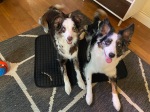

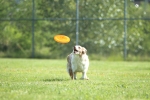
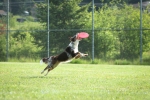

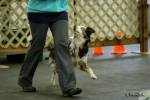

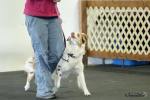
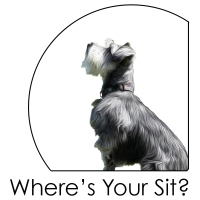
This is interesting reading, i have a 10 month old Border Collie, he gets 3 walks a day , of which one is an hour on lead, other two around half hour or so. he gets to play fetch twice a day for roughtly 10 mins, also training, learning new things, lots of cuddles and massage.also he has rest time twice during the day. He was a nightmare before i tried this , and i must say he has improved and is much much calmer now . I think there is definately a point when you can ” go to far ” with their exercise and its so difficult to get them to calm m back down again. it certainly works for me and my dog. .
LikeLike
Most working breeds need a lot of both physical and mental exercise. In this study they were considering whether it was worth the walk if the dog has an adrenaline rush when they see another dog. They were also looking at whether high arousal activity such as fetch would increase reactivity. This would apply to dogs with severe reactivity.
All dogs would benefit from long walks where they can smell and explore. It’s just not a good trade off when the dog is being triggered on the walk.
LikeLike
This confirms what I’ve seen with my young bloodhound who has reactivity issues. We were going on 3-4 daily walks before getting a fence, and every time he saw a dog (or kid coming at him on a scooter, etc.) his level of anxiety/excitement would increase to the point that the walk wasn’t even enjoyable anymore. Sometimes he even seemed like he wanted to just run home. Then every sound or movement outside for the rest of the evening would send him into a barking frenzy, so it was a never-ending cycle of stress for him. We’ve since been through some reactivity training which helped a lot, but he still often seemed overstimulated. We now do lots of training/mental stimulation both inside and outside rather than frequent long walks. When we do a daily walk, it’s at a time when there aren’t lots of dogs out and about in the neighborhood. Over the past month or so he has become so much more relaxed, and when he does see another dog he is much more responsive to me and can continue on without issue. I was worried we would have issues with hyperactivity, but this has not been the case at all!
LikeLike
That’s wonderful you were able to find a great balance for your dog! Reactivity is such a hard struggle and getting to where you are now is amazing! It’s also nice to hear experiences that back up the research.
LikeLike
I really would like more detail if I could on some of the excersises. Trick training ? Puzzle games? Thankyou.
LikeLike
Hi Sheila,
I will definitely be adding more blog posts on this topic in the future. Stay tuned!
LikeLike
i like your research. Dogs have a job to do that they are hard-wired to do. That is being a human’s best pet. If too much stimulation ,they become ‘doggy dogs’ and revert back to pack behavior. I tell clients that have a new puppy, with kids, ‘make sure the pup is treated like the toddler that it is’. Lots of rest, do not allow the children to constantly run the puppy ragged. I have seen parents allowing small children to ‘run over’ the dogs’ feet with the 3 wheeler they are riding and allowing it over and over again and the parents want to know why this pup/dog is acting unhappy and wants to bite the kids. We must understand that dogs need direction, given with kindness, no negative. A lot like children. Psychology research has shown dogs and kids are on the same tier in the household. Both are yelled at, both make messes. Children ,in the exam room, talk for the pet, a common occurrence.sp.?
LikeLike
Reblogged this on ZeroBites Dog Training and commented:
Great article, I am a big believer in enrichment games and other forms of activities that can help your dog, focus and listen as well as have a calming affect on them.
LikeLike
I’ve noticed this with all my clients as well. It’s nice to have the research to back up the anecdotal evidence.
LikeLiked by 1 person
I had no idea that too much exercise could alter a dog’s balance. This makes so much sense in retrospect. Definitely will need to share this !
LikeLike
I was pretty excited about this research too!
LikeLike
Would be interested to know where coursing events play into this study. I’ve “given up” with obedience and rally with my reactive girl. Agility tends to be the middle ground. However she loves nosework. However, also seems to love coursing. She tied she “sister” becoming the first Great Dane earning a BCAT title, has her CA and is working towards her CAA.
LikeLike
That’s amazing!
LikeLike
It’s the check in process that make me crazy with other “clueless” dog owners that try to check-in multiple dogs.
LikeLike
I know Jade missed out of the first year of socialization, never mind the abuse she suffered (physical and being malnourished). This, kills me with so much “talent” she has. Nosework has been our saving grace.
LikeLike
We just adopted a one year old WGSD that was not socialized. He grew up with kids (girls) and three other dogs, but is reactive (through fear I believe) to other people, mostly men, and other dogs. We have been using clicker training when we can get a male friend to the house to help train. We also take him to our training center to watch dogs play in the park from a distance. Not much seems to help when it comes to the other dogs. Is this just a time thing? Will he ever get over this and learn to play with other dogs? We think he would love it if he’d give it a chance. But we have a long way to go first. Thinking this is actually going to take a couple years at this rate.
LikeLike
Hi Elizabeth,
Sadly when dogs miss out on crucial socialization it can in fact have life long effects on them however I have seen even feral dogs improve over time. For some fearful dogs it can in fact take years and they will never be “Lassie” but over time you can see vast improvements. A great example is my Miniature Schnauzer who I adopted at 8 months. She hadn’t been exposed to dogs, kids, men, etc. Even a leaf blowing would set her off. It took over a year to work out the reactivity, another few years to build up her confidence to where she could run in agility and then another few years to get her comfortable with children. To this day her play skills with other dogs are rough but she can in fact play and also likes being around kids and men now. It was a lot of work but she has taught me a ton about animal behaviour. Best of luck to you on your journey!
LikeLike
Thank You for giving me hope. We’ll continue with what we’re doing and hope for the best. We love him no matter what!
LikeLike
My rescue German Shepherd cross, was exactly the same, I don’t think she will ever be totally calm as I said in my comment already but after 3 years she can walk past 90% of people with no reaction, we have a rule of no touch or eye contact with her on meeting and a handful of her favorite treat that she is not allowed until she has sniffed the newcomer and is happy, when she will then nudge their hand which means OK your good and now a friend, then she acts like your new best friend, this was from a great behaviorist and has worked brilliantly… Keep going it takes loads of time… Good luck
LikeLike
I have a highly reactive rescue dog, this article is really interesting, my dog won’t go out unless two people are there, crazy right. At home indoors she is calm and totally loving including to 3 cats, but other dogs and some people she goes crazy.. We have reduced her walks to quiet evening time and let her decided when to go home and she is so much better, if she doesn’t want to go out she doesn’t have to. I guess as with humans, some are sociable some not. Recognising dog body language has also helped hugely as has getting her to sit quietly and be calm as she can when another dog is near her rather than trying to pull her by… She is much better if we stand calmly chatting with her than tensing up and speeding up.
LikeLike
I’ve come across quite a few reactive dogs who do better when more humans are present on a walk (which can present some challenges to me as a trainer when I’m working with owner & dog and everything is going great just because I’m there)! It sounds like you’re doing an amazing job of reading your dog and letting her set the pace.
LikeLike
Wow I’m so pleased your article popped up on my FB page! I shall read the full study. We have a nearly 3 year old Airedale terrier who is very reactive to the smallest sound in the house/garden, and can’t abide birds on the fence or cats, they make him apoplectic either in the garden or out on a walk. He and I got attacked by a dog at training 10 weeks ago. I’m still recovering physically and mentally from serious injuries and goodness knows how it is for him. He’s certainly more aware/unsure of other dogs when we are walking.mive just begin to walk him again myself sometimes. I’m very interested in this play v walking. I’ve always tried to play games with him in the house as when his walking was restricted due to an injury as a pup we had to find other ways to tire him out than walks! We are taking him to a top behaviourist here in the UK Monday for some help/advice, really hoping it helps. I hav e learned from a dog whisperer last year that he finds it hard to bring himself down after he’s been stimulated by a dog/passerby/ etc when at home and to a degree when out; there are some dogs he really takes against and barks at (I’m pretty sure thru fear/anxiety) so when I’m at home and he gets wound up, I now help him “come down” with energies which is helping him help himself, the bark now turns to a howl and he eventually calms down. I will follow you now ive found you, shame you’re so far away! The other thing I’m trying when walking is to keep tuned into him and on the lookout for dogs I know are a problem for us, so I’m prepared for the response or we can take evasive action. He’s happiest when off the lead in fields (me too if I’m honest) following his nose. Interestingly he plays v well with other Airedales, bitches are always best for him. Yesterday we had a first, I try to strip/ groom him myself but due to my injuries have had several weeks break from this. I’m just restarting now, I sat on his bed and his head was in my lap and he happily allowed me to strip his head/neck area while he dozed. It felt wonderful and I will certainly try this again. He’s not a dog for cuddles!
LikeLike
Sounds like you have both been through a lot!
You may find Dr Sophia Yin extremely helpful too. Here’s a video from her blog where she’s working with a reactive dog: http://drsophiayin.com/resources/video_full/podees_aggressive_to_other_dogs
LikeLike
This is fabulous advice. Great article & extremely useful 😊
LikeLike
This is great information!
We have a 1 and 1/2 year old Chihuahua x Miniature Schnauzer. He’s ridiculous to walk. Always on guard and ready for confrontation. He goes to daycare twice a week and loves his pack of 20. But put the Leah on and it’s fight time.
He’s lovely at home & with our young kids. We’ll try some of these training games with him.
Thanks!
LikeLike